- Know about and see ruins of the Keshava Sri Swambhu temple inside Warangal Fort. What a temple it must have been.
It had been a long day of travelling and exploring different Kakatiyan temples in the remote village of Pillalamari in Telengana, and when we finally journeyed towards the Warangal fort it was already late afternoon, and we had just a couple of hours in hand before the fort premises would shut down for the day. Exhausted from the day’s travails, when we reached the fort we noticed with a trifle feeling of disappointment that nothing much remained of the fort walls or gates.
However,
when we reached the ASI park, which lies in the central part of the fort, we
found that what remains for us to see are imposing stone ruins of a medieval
temple. This temple, known as the Keshava Sri Swambhu temple, was
built by the great Kakatiyan ruler Ganapathideva in the 13th century CE, and
later destroyed by the army of Muhammad bin Tughlaq in 1323, when the fort
finally fell to the Delhi Sultanate, after repeated attempts to capture it.
The massive ruins that are now scattered all over the park, tend to overwhelm the viewer with their beauty and splendour. There’s also an ensuing feeling of sadness seeing the waste, with the thought that how grand the temples must have looked in their heyday; more so for us as we gazed at the ruins in the fading light of the setting sun.
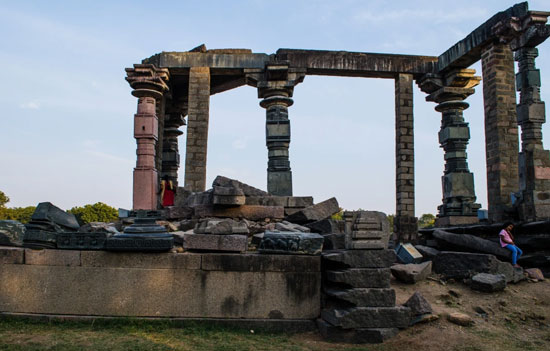 Glimpses of past
splendour in Warangal fort temple ruins
Glimpses of past
splendour in Warangal fort temple ruins
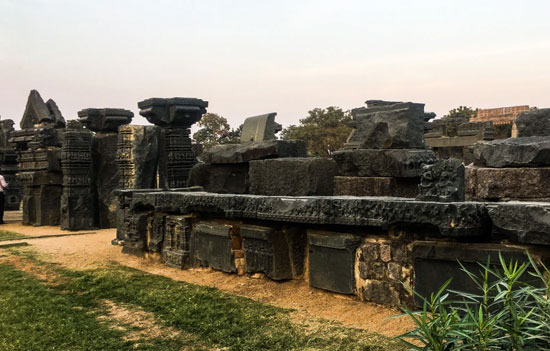 Temple destroyed by the army of Muhammad bin Tughlaq in 1323.
Temple destroyed by the army of Muhammad bin Tughlaq in 1323.
Full
caption - While the general theory holds that the temple was destroyed by the army of Muhammad bin Tughlaq, there’s an alternate theory that believes the temple was destroyed by a general of the Qutb Shahi dynasty during the reign of Ibrahim Qutb Shah of Golconda
From various inscriptions it can be held that Warangal started developing as an outpost during Prola I’s rule (996 CE- 1052 CE), when the Kakatiyas ruled as vassals under the Kalyani Chalukyas with Hanamkonda as their capital. According to some reports a bullock cart had toppled over a stone in Warangal, and in the morning the cart-men discovered that their wheel had turned to gold.
King
Prola, after being informed of this miracle, came to inspect and found that the
stone which had caused the cart to topple and the miracle to happen was a
lingam, which was termed as swayambhusiva,
meaning a natural lingam not created or installed by humans. He was
advised to build a temple around it (Sambhunigudi),
while the place was named Orugallu meaning a fallen cart. Since an ‘orukal’ or a single large rock had caused the accident, the place was also known in Sanskrit as ekopala (derived from orukal) or ekshilanagari.
It was however much later, during Ganpathideva’s rule, that Orugallu gained political importance, when the fort was completed, and the Kakatiyan capital was shifted here from Hanamkonda in 1208 CE. The fort was initially made of mud brick walls, which were changed to stone by Ganapathideva for better protection.
However,
owing to constant wars with the Yadavas, Rani Rudramma made further
reinforcements by adding thick granite stone layers to the walls, increasing
the height of the fort walls, building three concentric layers of fort walls
with bastions and a wide moat, thus turning it into one of the most formidable
forts of that time.
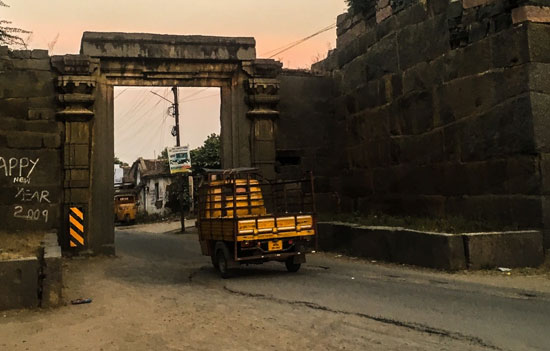 The thick fort
walls and the trabeated fort gates.
The thick fort
walls and the trabeated fort gates.
Full
caption
- Very little remains of the once formidable walls, but from whatever is left,
we can still see the massive granite blocks used for building the walls.
The temple
From
the various broken pieces recovered from the fort temple ruins and from a text
named Kreedabhirama, it has been derived that the site was likely to have
had three separate temples: Keshava-Sri- Swayambhu; with Vaishnavite panels
belonging to the Keshava temple, two of the women panels found likely to belong
to the Sri (Lakshmi) temple, while the Shaivite panels were a part of the
Swayambhu temple. The ruins are spread across the archaeological park in the
fort, while some artefacts are on display in the single roomed museum housed
within the Khush Mahal located inside the fort, and some more are kept in the
Hyderabad museum.
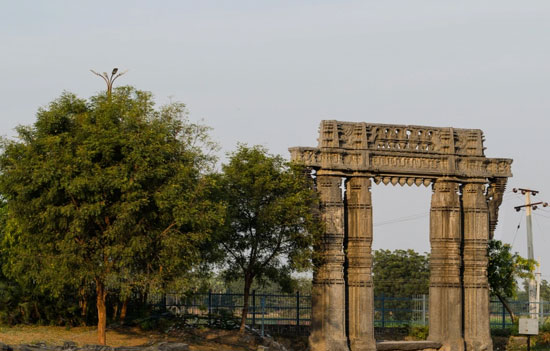 The well-known symbol of the state of Telangana: the kala-toranas or gateways that once stood as doors to the temples.
The well-known symbol of the state of Telangana: the kala-toranas or gateways that once stood as doors to the temples.
Full
caption
- Beautiful and imposing, these double pillars support a broad architrave that
holds the mythical bird known as annapakshi on either ends.
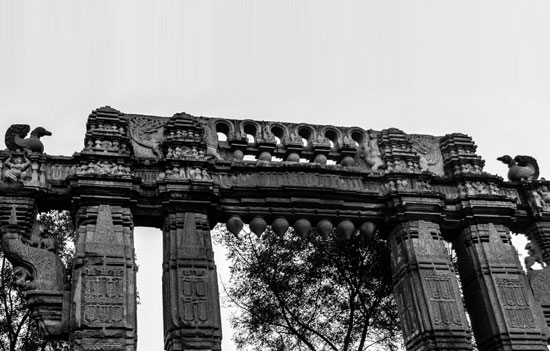 Intricate carvings on the four grand gates or kala-toranas include figures of animals, garlands in loops, bharbahakas, and lotus buds.
Intricate carvings on the four grand gates or kala-toranas include figures of animals, garlands in loops, bharbahakas, and lotus buds.
Full
caption
- Curiously, as per the ASI report, one of the gates also carry the figure of
the yakshini Padmawati.
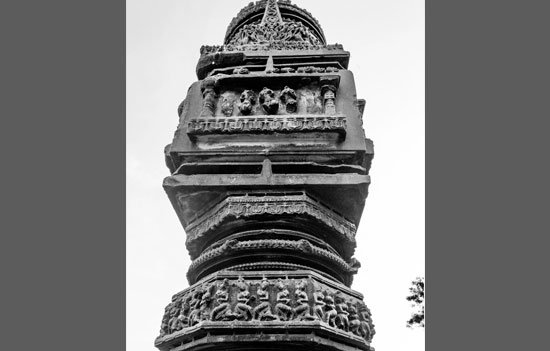 Dancers on pillars. Maybe they once adorned the pillars around the circular rangamandapas.
Dancers on pillars. Maybe they once adorned the pillars around the circular rangamandapas.
For
more on dancers in Kakatiyan temples click Here
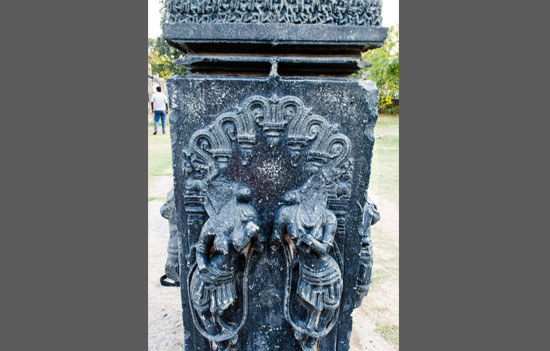 Dancers on pillars.
Dancers on pillars.
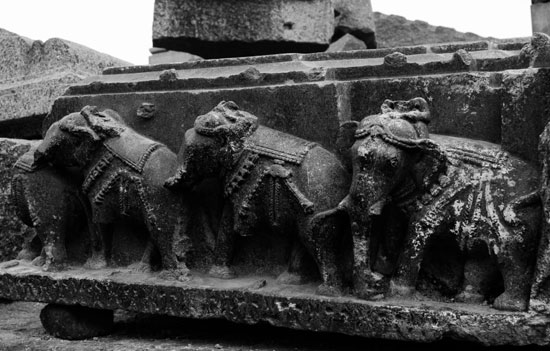 Elephants are a popular theme in Kakatiya temples.
Elephants are a popular theme in Kakatiya temples.
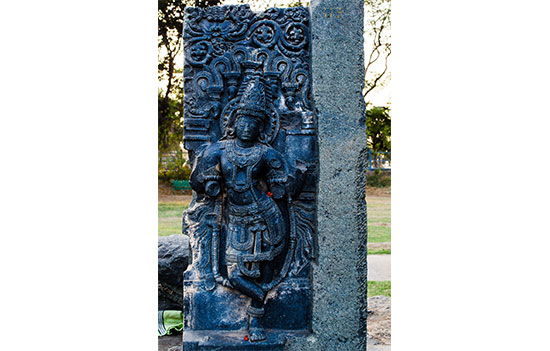 Massive blocks of stone.
Massive blocks of stone.
Full
caption
- These massive stone blocks with concentric circles carved in them would have
once been at the top of the mandapa pillars just below the cross capitals, as
is seen in the Ramappa temple in Palampet.
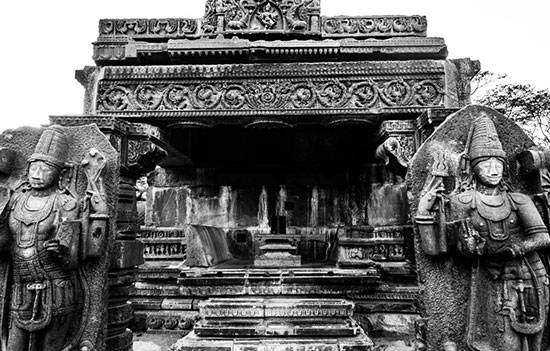 Massive blocks of
stone.
Massive blocks of
stone.
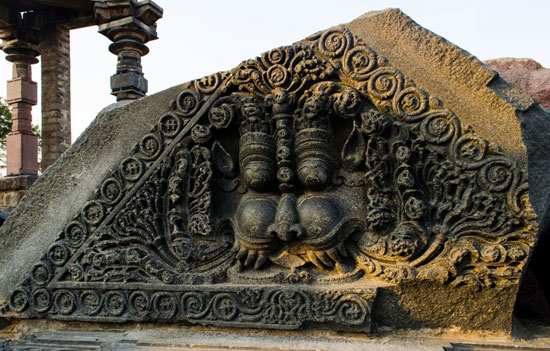 Kirtimukhas- a popular motif in Kakatiyan sculptures.
Kirtimukhas- a popular motif in Kakatiyan sculptures.
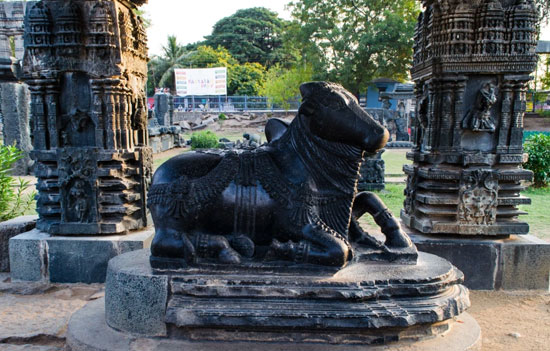 Kakatiyan nandis.
Kakatiyan nandis.
Full
caption
- Kakatiyan nandis are unique in the sense they wear a very natural look and
pose. The bulls were carved keeping them as real as possible, and often the
veins on their noses are prominently seen. Exquisitely carved ornaments
decorate the massive Kakatiyan stone nandis.
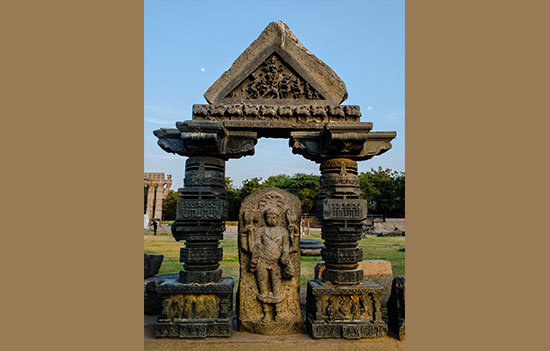 Decorative Panels.
Decorative Panels.
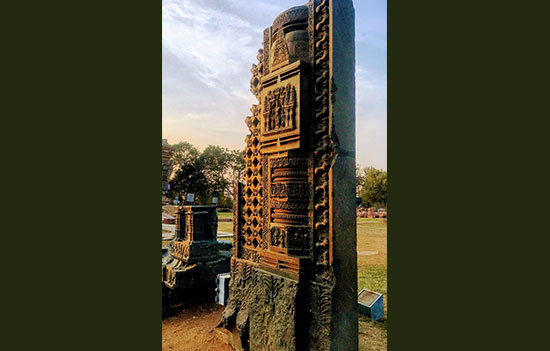 Carvings on dwara shakhas (pilaster of a door jamb). The jalis on the doorways of Kakatiyan temples were exquisitely carved.
Carvings on dwara shakhas (pilaster of a door jamb). The jalis on the doorways of Kakatiyan temples were exquisitely carved.
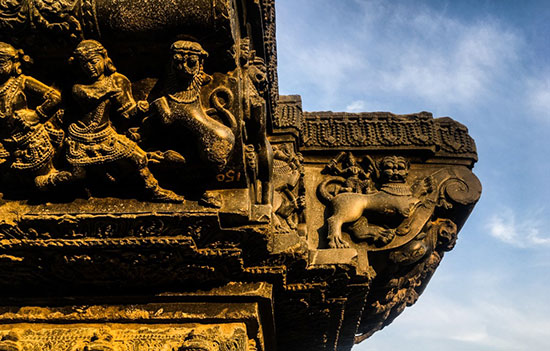 Simhas and warriors on cross capitals.
Simhas and warriors on cross capitals.
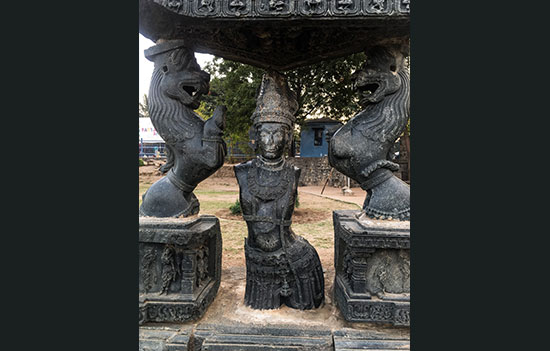
The fort museum in Khush mahal
Artefacts
are just kept scattered outside, while some murtis are on display in the room
inside. It houses a beautiful decapitated head of a nandi, head of Shiva,
Vishnu, some Jain inscription pillars, simha brackets, and few broken door jamb
panels with jaalis.
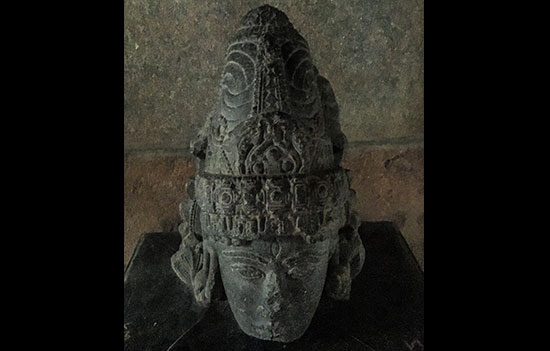 Known as Prataprudra’s head, this is the head of Shiva.
Known as Prataprudra’s head, this is the head of Shiva.
How to reach Warangal fort, and other things to see
We stayed in Hanamkonda, which is considered the twin city of Warangal. From Hanamkonda the fort is just around half an hour by car. The vehicle takes one straight up to the ASI park gate where the temple ruins are seen. The remains are scattered all over the park and it takes one or two hours to see the pieces in details. If one is interested in seeing more temple artefacts that are kept in the Khush Mahal, it’s just a short walk from the park gates. The mahal, built after the fall of the fort, is rectangular in shape, has large sloping walls, with six arches that act as openings to this single celled structure. There are stairs that lead to the top of the mahal, and one can get an aerial view of the entire fort or what remains of it.
Given
below is a map that shows the other interesting historically important places
in Hanamkonda. Thousand pillar temple, Padmaskhi temple, and Bhadrakali temple,
are all of Kakatiyan era, and each one is an architectural masterpiece, and a
must visit for all heritage enthusiasts and history lovers. Best time to visit
Telengana is during winter, in December or January. Local food is spicy but
quite tasty, and a must try.
To read all
articles by author
Author studies
life sciences, geography, art and international relationships. She loves
exploring and documenting Indic Heritage. Being a student of history she likes
to study the iconography behind various temple sculptures. She is a well-known columnist
- history and travel writer. Or read here
Article was first published on author’s blog and Here
Article and pictures are courtesy and copyright author. eSamskriti has obtained
author permission to share.
Also read
1.
Albums on
Temples of India
2.
Appreciating Indian Temple Architecture – an Indian viewpoint
3.
Space and Cosmology in Indian Temples – Angkor Watt
4.
Lepakshi
Temple, Andhra Pradesh
5.
Why
do Temples have Tanks and Step-wells